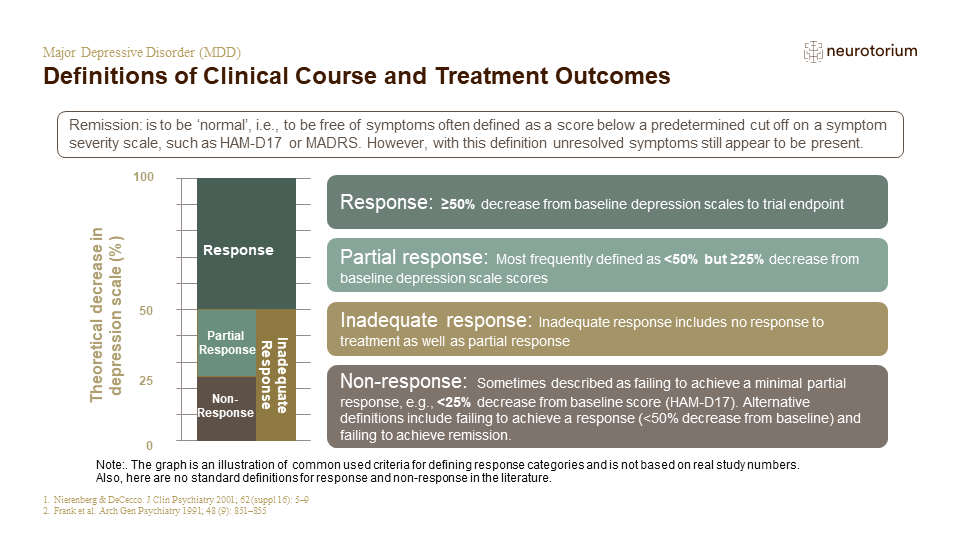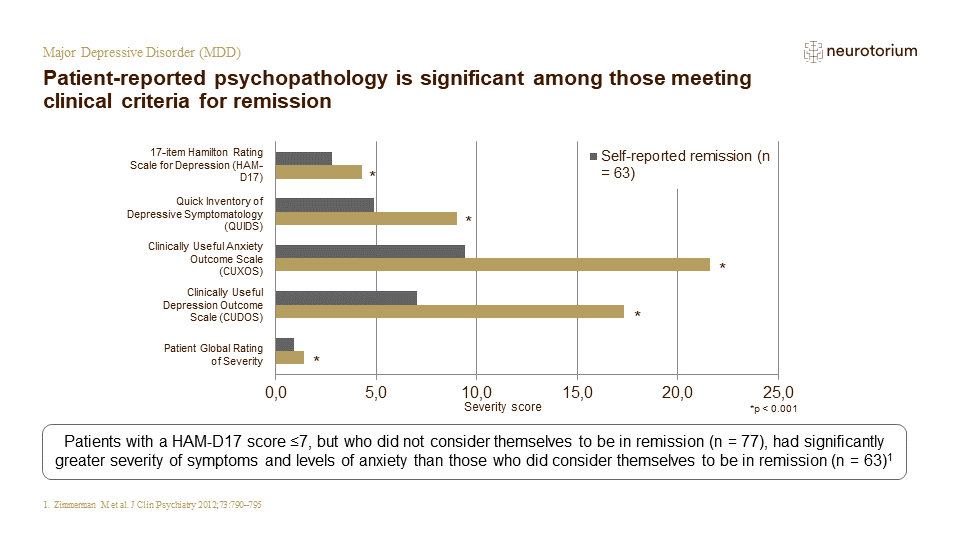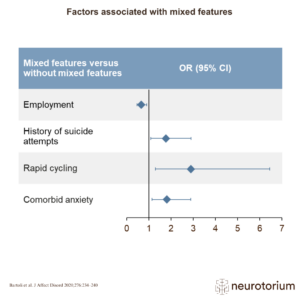Index for
slide deck
Title
-1024x576.jpg)
Definitions and Diagnosis
Definitions
-1024x576.jpg)
Definitions
-1024x576.jpg)
Depression
This slide shows core definitions for depression based on World Health Organization’s ICD-10 classification system or the American Psychiatric Association’s DSM-IV and DSM-5 system.
References:
NICE CG90. Depression in adults: recognition and management. 2009. Update Apri…
-1024x576.jpg)
Depression
Reference:
American Psychiatric Association. Diagnostic and statistical manual of mental disorders 5th edition: American Psychiatric Association. 2013
-1024x576.jpg)
Depression is a clinically heterogeneous disorder
!--?xml version="1.0" encoding="UTF-8" standalone="yes"?-- References:
American Psychiatric Association. Diagnostic and Statistical Manual of Mental Health Disorders. 5th ed. Washington, DC: American Psychiatric Association; 2013.
Jaeger J et al. Psychiatry Res 2006; 145:…
-1024x576.jpg)
Cognitive symptoms of depression have a negative impact on many aspects of the patient’s life
References:
McIntyre RS et al. Depress Anxiety 2013; 30(6): 515–527.
Hammar A, Ardal G. Front Hum Neurosci 2009; 3:26. doi: 10. 3389/neuro. 09. 026. 2009.
-1024x576.jpg)
MDD symptoms – American Psychiatric Association
The American Psychiatric Association (APA) describes nine depressive symptoms for diagnostic purposes.[APA, 2013]
Depressed mood
- Patients may describe their mood as depressed, sad, hopeless, discouraged, or ‘down in the dumps’.[APA, 2013] Alternatively, the patient may d…
-1024x576.jpg)
MDD symptoms – The Montgomery-Åsberg Depression Rating Scale
The Montgomery–Åsberg Depression Rating Scale (MADRS), which was designed to be sensitive to the effects of antidepressants, includes ten depressive symptoms, six of which are described as ‘core symptoms’.[Montgomery & Asberg, 1979; Bech et al., 2002]
MADRS item 1. Appare…
-1024x576.jpg)
The course of MDD
This slide illustrates the typical course of illness for patients with depression. Discontinuing antidepressant treatment in the acute phase before full symptomatic remission drastically increases the likelihood of relapse of the original episode, and discontinuing treatm…
-1024x576.jpg)
MDD is a complex, often recurrent and remitting disorder
!--?xml version="1.0" encoding="UTF-8" standalone="yes"?-- Previous slide illustrates the typical course of illness for patients with depression; either receiving only acute-phase treatment or receiving longer-term treatment designed to prevent relapse. It also highlights…
-1024x576.jpg)
Depression – signs and symptoms
The slide aims at giving a simple definition for the terms signs and symptoms. It also highlights that the criteria used in the diagnostic manuals cover all major signs and symptoms of depression.
Reference:
Shivani, et al. Alcohol Research & Health. 2002;26:90-8
-1024x576.jpg)
Definitions of epidemiological terms
The slide explains the difference between prevelance and incidence as key epidemiological terms. While prevalence is the number of persons with disease, in a given population, at a designated time, the incidence looks into the number of new persons with disease over a spe…
-1024x576.jpg)
Definitions of burden of disease and key epidemiological terms
This slide gives definitions for key epidemiological terms used in studies to quantify the burden of a disease. Term defined are the Burden of disease (BoD), Quality adjusted life years (QALYs), Years of life lost (YLLs), Years lived with disability (YLDs), Disability adj…

Definitions of Clinical Course and Treatment Outcomes
References:
Nierenberg et al. J Clin Psychiatry 2003; 64 (suppl 15): 13–17; page 13 (‘Remission, relapse, recurrence’ section).
Riso et al. J Affect Disord 1997; 43 (2): 131–142.
Nierenberg & DeCecco. J Clin Psychiatry 2001; 62 (suppl 16): 5–9; page 8.
Frank et al. Arch G…
-1024x576.jpg)
Definitions of Clinical Course and Treatment Outcomes
MDD is a chronic disorder, most frequently characterised by relapses and recurrences.[Frank et al., 1991] Relapse can be defined as an episode of MDD that occurs within 6 months of response or remission;[Nierenberg & Petersen 2003; Riso et al., 1997] theoretically, relaps…


-1024x576.jpg)
-1024x576.jpg)
-1024x576.jpg)
-1024x576.jpg)
-1024x576.jpg)
-1024x576.jpg)
-1024x576.jpg)
-1024x576.jpg)
-1024x576.jpg)
-1024x576.jpg)
-1024x576.jpg)
-1024x576.jpg)
-1024x576.jpg)
-1024x576.jpg)
-1024x576.jpg)
-1024x576.jpg)
-1024x576.jpg)
-1024x576.jpg)
-1024x576.jpg)
-1024x576.jpg)
-1024x576.jpg)
-1024x576.jpg)
-1024x576.jpg)
-1024x576.jpg)
-1024x576.jpg)

-1024x576.jpg)


